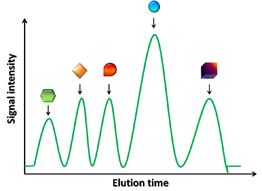Allows the analysis of the components of complex mixtures by means of separation based on the different rates at which each chemical component migrates across a column.
dating
morphology
technology
origin
composition
alteration

Metal

Mortar

Stone

Wood
Metals & Alloys
Frequently used to characterize metal corrosion products, such as organic acids that are highly aggressive towards metal materials, as well as common metal corrosion products like salts.
Stone, Mortar & Plaster
The composition of black crusts and atmospheric deposits can be characterized by means of GC-MS, allowing to examine and monitor the surrounding environment and the decay factors, source and rates of stone materials.
The presence of microorganisms on the surface of buildings can also be detected by identifying products of microbial metabolism, such as organic acids, using GC-MS or HPLC.
IC is employed for the determination and depth-profi ling of soluble salts (mainly chlorides, nitrates and sulphates) in historic stone and mortars. The method is also employed after salt-reducing treatments in order to examine their eff ectiveness (Stuart, 2007).
Wood
Degradation of wooden building materials is often monitored by means of chromatographic methods. More specifi cally, chemical alteration products of wood components (cellulose, hemicelluloses, lignin, extractives, etc.) are identifi ed and quantifi ed with HPLC (Kacík at al., 2014).
Liquid chromatographic methods are also employed for distinguishment studies of similar wooden species: a single chemical compound* can function as a marker (Kite et al., 2010).

Chromatogram
Chromatography is the general term that includes all analytical techniques that separate and analyse the components of a complex mixture. Once separated from the rest of the sample, the chemical species of interest can be identified and quantified. It is a diffused separation method used in various fields, including historical building materials characterization and – in particular - the isolation and characterization of the organic and inorganic compounds* associated with their weathering. Produces chromatograms with the quantity of each compound present in the sample. The chromatographic techniques mainly used in the field of Cultural Heritage include:
accuracy
time
cost
in situ
invasive
destructive
Chromatographic separation of mixtures of compounds* is based on their partition between a mobile (a fl uid the mixture is dissolved in) and a stationary phase (a material or structure holding another material), in a chromatographic column. The principle chromatography is based on is the diff erent rates at which each chemical component (called analyte or eluent) of a mixture is carried by the mobile phase through the system and across the chromatographic column in a definite direction. The final output is a “chromatogram” which shows the time of elution (on the X-axis) and the quantity of each component present in the sample (on the Y-axis) (Stuart, 2007). Elution times are then compared to databases of known compounds* in order to identify the different components (qualitative analysis), whereas peak areas or heights are calculated in order to determine the concentration of each compound* (quantitative analysis).